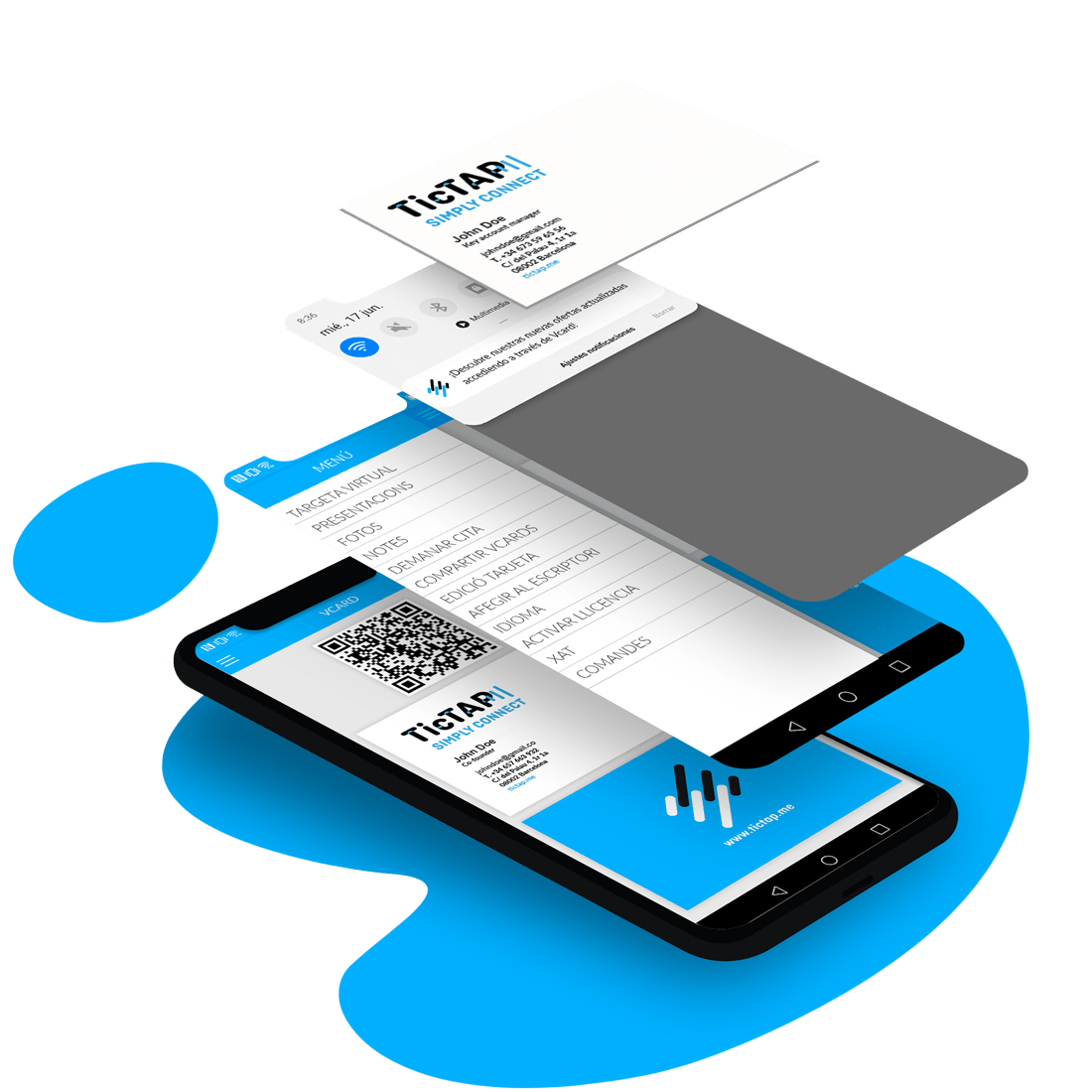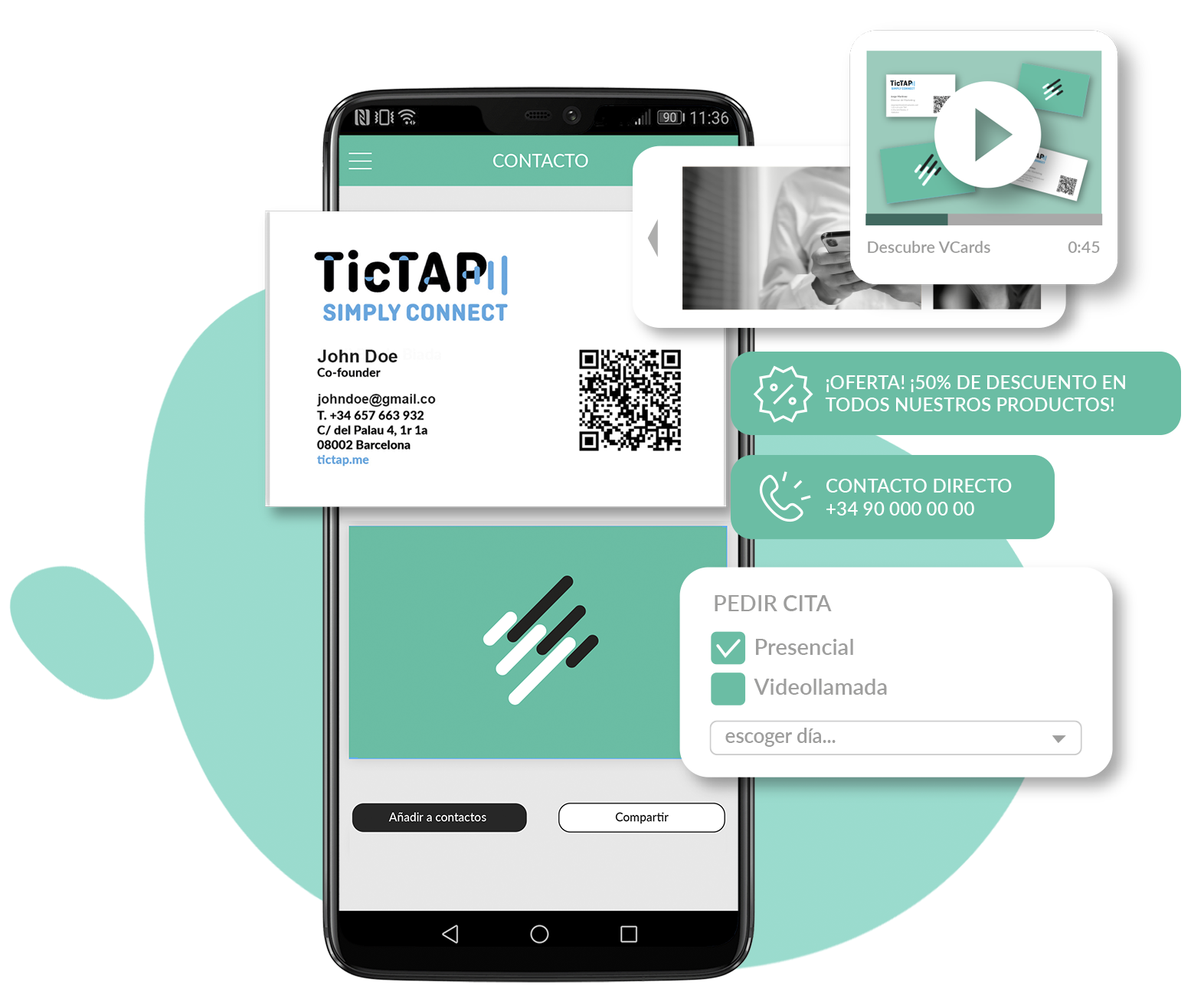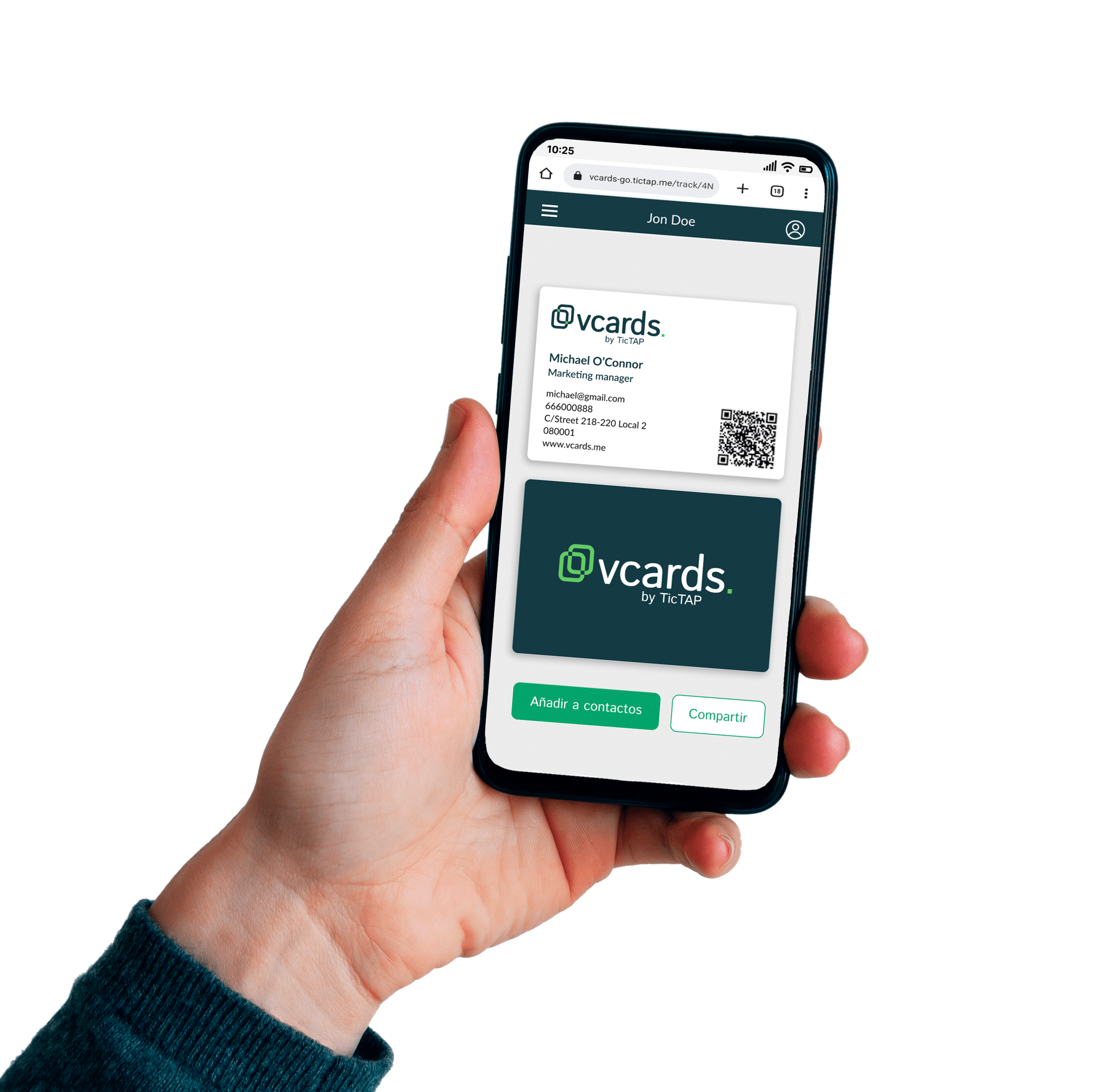Digital business cards have their advantages and disadvantages, like everything else in this life. Let’s have a look at these virtues and limitations so you can decide if it’s in your best interest to give way to the digitalization of your presentation and contact tool.
Without being a spoiler, I will advance you that digital business cards can be very useful. However, they are very limited with respect to Smart business cards, as we will also see in this article.

Advantages of digital business cards
1. Ideal during the pandemic
With the current situation the face-to-face meetings have declined. A large part of these meetings are now made through calls and videoconferences. This transformation has not only occurred for meetings. Other events such as fairs are being held in digital format.
In this new environment, traditional paper business cards are completely obsolete. You can’t give them to the client, since you’re probably not even physically reunited. A digital business card is the solution, as it will allow you to easily share it using the QR code or facilitating the link contact-less to the person of interest.
2. Flexible and more varied content
Apart from the first name, surname, position, address, email and telephone, a digital business card allows you to include many other types of content. Some examples of this are: links to social networks, the curriculum and information on the work experience of the holder, etc.
In addition, if at any time any data changes (name of the position, address, telephone…) the update is immediate.
With the paper format, you would have to throw them all away and wait for printing, or cross out and write the new data by hand, and ask for more updates.
3. Collaborate to take care of the environment with digital business cards
Being digital you avoid paper and, not only that, but also printing, inks, etc. In this way you get contribute to the improvement and care of the environment.
This point is also especially interesting because many times business cards end up in the trash even before the person who received it registers it on their mobile. That is to say, that all those natural resources used or the impact they cause on the environment, they do not contribute anything to the growth of your business, sales, etc.
You can believe that this point is not so important either. But today brands can no longer just say “We do things well, with quality”, because the public already usually take these two points for granted. They don’t make you any different. That’s why branding is changing and businesses are turning more and more to values.
If you stop to think about the ads you see today, how many talk about doing things well and how much more importance is given to other values such as safety, freedom, being a winner, or good parents or having quality of life if you consume their product…
Ecology and sustainability are two good values with which more and more people connect. If they are among the hesitation to buy from two potential suppliers, these values are the ones that can add extra points to move the balance for one of them and discard the one that does not.

4. Lower cost for its creation
The logistic and economic cost of traditional business cards is high. You don’t just have to pay for materials and printing. In many companies with a staff of workers already a little large, they end up having a person who dedicates part of his work to the task of collecting data for new cards, check that they are correct, talk to the printer…
this person usually creates an excel or a Google spreadsheet. It includes all the details of the new cards to be ordered. Once this is done he sends it to the design department, or to the external design studio that prepares the design if there has been any change in it. Once you have the originals you should review them, because if there is an error there will be no going back after printing.
Finally, the files have been validated and sent to printing. If there has been no change in design, the printer will still ask you to validate the data before printing. This person will always have to review and validate the data at each step of the process. If anything is wrong, it will be modified and sent back to the company for the person to validate if the files are completely correct now, before printing them. This whole process ends up being very slow and consuming many hours for a company person.
Digital business cards avoid these costs. The person in charge of making the business cards of the company can directly enter the data of the new workers or modify the existing ones in the application or digital card platform.
If you want to change the design, you will have to go through the design part, but it will be much more agile and simple because you do not have the limitations of printing. If a data is incorrect, even if the person responsible for making the digital cards is not aware, it is enough for the cardholder to communicate it to that responsible person so that at a time he enters the card management platform and modifies it. No extra costs and always more agile than with the paper format.

5. Lower cost in data logging
Paper business cards mean that if you go to a meeting you give a card to the other person and the other person, after the meeting, will have to register it on his mobile and save it in his physical card box at the office. This entails two limitations:
- It is possible that the other person forgets after registering it and your data falls into oblivion of a jacket or wallet.
- If the person receiving your card does not forget, they will register it when they arrive at their office, or give it to their assistant to do so. This record is a waste of time in a mechanical task that does not bring any kind of professional growth or interest to who does it, whether it is your direct contact or his assistant.
The situation gets worse if instead of a meeting the event was a fair or a congress. In these types of events, the contacts you have made do not return to your office with just your card, but with a good handful of them. As a result, the time spent recording the data is significantly increased. What’s more, it’ll be the same for you with all the cards you get, too.
With digital business cards, who receives the card registers it directly on your mobile. With the vCard format, introducing the card into the company’s digital card registration system will also be much more agile and comfortable.
6. Digital business cards are always available
With digital business cards you just have to make sure that you have your mobile, and with battery, of course! Although this probably is already taken into account in your networking events and current meetings.
Therefore, it will no longer be the case that you forget the cards in the office or in the car, or that you run out and have to wait to print more again.

7. Multi channel
Digital business cards usually have several ways to share: QR code, link sending by Whatsapp, email, sms, Bluetooth, social networks…
How you can share them will depend on the choice of digital card you make and the options that the platform to create it from.
8. Differentiation
While your competition continues to give out paper cards, you can introduce yourself with your digital card showing your differentiation in all the details. The first impression is crucial. It can help you create a good impact by presenting yourself with a digital business card that allows your prospects to automatically integrate your data into their mobile and/or contact system without wasting time.
When you talk to them after doing things well, effectively, etc. you will have more credibility when they see that you really move with that way of doing even in the details.
The advantage of differentiation will disappear over time because such cards are more widespread. But even so, its positive impact of ease on data sharing without wasting time, will remain for your prospects and prospects.
9. Many more possibilities to offer your customers and prospects
Digital business cards appeared on the market some time ago, but everything that can be offered with them is still being explored. The reality is that more and more possibilities are being added. At TicTAP we differentiate between digital business cards, which are basically the life-long card converted to online format, and Smart business cards.
A Smart business card goes far beyond offering data. It’s about having a digital card that when the other person receives it and opens it is not only with that information, but with many more tools and options. You can even have several sections with text, forms, or send notifications, etc.
In this way, when the other person wants, you can reopen your link or use the QR code you provided in the product you sold, and contact you through a contact form. Or you can do one-to-one marketing campaigns by offering a new product or offer only to contacts you know will be interested. They will receive that message in the form of notification and SMS on their own mobile.
An example of a Smart business card is the TicTAP Vcard. If you want more information about them, you can find it here .
With the TicTAP vCards, your business cards become a kind of webapp easy to create and maintain for you, which your customers or contacts will be able to access and perceive as if they were a simple application with different options, but will not require any installation on your mobile because they will access through the same web browser of your device.

Disadvantages of digital business cards
As we have seen, these types of cards have many advantages, but it is not all gold that shines. You need to be well informed about the pros and cons so you can make the decision that is best for you. So let’s now look at the disadvantages that we should also consider:
1. Design limitations
This limitation will largely depend on the solution or platform used to create the digital card. Depending on which one is chosen, we can enjoy a wide variety of design possibilities or a few very limited options.

2. Ensure a good design adaptation in devices
It is true that paper is much more restrictive because it is a limited physical space. But if it has an advantage it is that once printed it is already like that for everyone. It will not change or look different because the person keeps it in a card box or other, etc.
Instead, a digital business card will be seen on a mobile or tablet. The size of the screen will make in some cases, if the screens were not considered very small, the data look poorly positioned or even remain outside the screen.
Although it is true that you can play with the option of scroll for very small screens, or offer different pages and sections (as in the case of ticTAP vCard, etc.) to avoid data saturation on a single screen and be able to give more information at the same time, information and options, it is important to think well about the design and adaptability of your digital business cards.
That is, the design of digital cards should be well taken care to ensure that your virtual business cards:
- adapt correctly to different devices;
- are functional;
- offer high usability to users.
And for this, it will be worth investing in the design phase and that someone expert in this area makes a good design that meets all the requirements of use and technical. It’s not just about branding and aesthetics. Otherwise, you may end up with hard-to-read or hard-to-use digital business cards from the recipient.
This point is not exactly a disadvantage but rather a risk in the case of not making a good design. It takes us to the key that well-understood design is both functional and attractive. And it reminds us that, although it is always important in our communication materials, it is still more important in the digital world where it can mean that users do not see the data, etc. if it is not well thought out and adapted.
3. Acceptance level of digital business cards
This has been a disadvantage that slowed many professionals and companies to start using this type of card. Many people felt that their target audience would not easily accept such cards, that they would prefer traditional ones or that paper had more impact.
With the pandemic we have advanced at a technological level in a year what we would have advanced in years without it. This is not just an advance on what technologies and the digital world offer. We are also talking about the acceptance of the digital world by companies and society in general.
Thus, the barrier of acceptance of digital business cards seems to have decreased greatly, if not almost disappeared. However, it may still be a possible barrier for some target audience profiles or for certain more conservative sectors.
Do digital business cards suit you?
After seeing what digital business cards are, their many advantages and their few disadvantages, it is time to make the decision.
If one of the disadvantages has enough weight to unmark all its advantages, the thing is clear. But probably all its advantages will bring you much more, since most of the inconveniences are easily salvageable. In addition, with the current pandemic, the digital world is rapidly gaining positions.
So, the next interesting discussion is rather which digital business card platform, or Smart digital business card, gives you more game when it comes to creating card templates.
You should also consider the point of how to have a design expert, either internal or external, for the specific design phases that you must do if you see that this point escapes you to do it yourself. Keep in mind that the design phase is primarily to create the template, and then just some more phase when you want to make some design changes or add some functionality.

